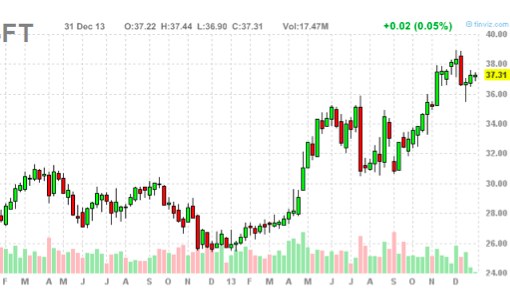Running with the herd, ignoring valuations, buying the dips, and staying exclusively in domestic stocks produced the winning market strategy last year. Time-honored approaches like diversifying, thinking “margin-of-safety,” focusing on where the values are, and being contrarian generated lower returns.
The American stock market moves relentlessly higher mostly because investors are happy to pay more for each dollar of earnings. The S&P 500 Index (SPX) is up over 50% in the past 2 years but earnings are only up about 12%, according to my research. In my opinion, this represents the biggest non-recessionary price-to-earnings multiple expansions for half a century.
Clearly P/E multiples cannot expand indefinitely because, among other things, stock prices mirror growth in earnings over the long term. There is, however, no law that says P/E multiples cannot continue to expand in the near term.
Most people instinctively assume the recent past is prologue to more of the same. Given the upward move in the U.S. stock market, the prevailing view for 2014 is unsurprising: staying with the bullish crowd will continue to produce good results. In my opinion, nearly everyone is expecting a 10% rise this year.
Fear of losing out on making money is replacing the simple fear of losing money. Money is flowing out of underperforming assets such as bonds that are supposed to anchor a portfolio and into US stocks.
A massive rally from bear market lows of 5-years ago has roused the “animal spirits,” and while we can’t say for sure our best guess is that the fear-to-greed cycle has not yet run full-cycle. A return to fearfulness is a story for another day.
Optimists say the US market’s rich valuation is defensible. We are the developed world’s best place in terms of projected economic growth, we are on the verge of energy independence because of the revolution in drilling technology and our corporations are highly profitable. There is a glut of world savings and the US will be the destination for much of it.
US stocks are expensive but current levels of valuation are not unprecedented: from the late 1950s until the early 1970s; and again, from 1991 until 2004 the US Market was at similar levels of valuation. So, given low interest rates, these heightened valuations can remain for an extended period.
The favorable narrative for US stocks is compelling, feels plausible for the period just ahead and we are rooting for it to happen. We believe, however, there are reasons for caution when looking at US stocks as an asset class.
In the short-run investor sentiment numbers, short sales data and insider selling activity are all flashing yellow light. Given these readings and other short-term gauges, a 5-7% decline in stock prices would not be unusual, even if later in the year the market continues to move much higher.
In the long-run, gauges such as Tobin’s Q ratio, which compares share prices to the replacement value of assets, Shiller’s P/E, which considers long term valuations and the current market capitalization of US stocks relative to GDP, all portend very low average annualized returns over the next many years.
If these indicators are correct, a long-term passive investor in the S&P 500 will do just as well, if not better, by simply owning a 10-year Treasury bond at 3%.
Another useful long-term indicator is provided by Value Line, an investment publication that has been around since the 1930s. Their analysis indicates the current “median price appreciation potential of all 1,700 stocks in the hypothesized economic environment 3 to 5 years hence” is 30%. By 30%, they don’t mean 30% a year compounded; they mean a simple 30% over the entire period!
To put 30% in context, it is lower than the levels reached before the financial crisis at the market’s peak in 2007. Back then Value Line was projecting appreciation potential of 35%. The actual 5-year performance from those highs was negative.
The Value Line indicator is not always gloomy. At the bottom of the market in March 2009, it cheerfully predicted appreciation potential of 185% and with three months to go, we are nearly there: the market is up a very merry 170%.
In summary, resurrected “animal spirits” are propelling this market higher and the odds favor a continuation, with setbacks, throughout 2014. But be prepared. If the market chugs higher, the implied long term return from American stocks will soon enter negative territory.
Strategy: The developed world continues its process of deleveraging made necessary from the bursting of the credit bubble some 5-years ago. Deleveraging produces deflation and there is scant evidence to suggest our world is anything but deflationary.
This is also the view of central bankers and notwithstanding the Fed’s decision to taper its asset purchases, the policy of zero short-term interest rates and liquidity pumping will remain with us for quite a while yet.
In the stock market our strategy is to focus on pockets of reasonable valuations. In a nutshell, we want to own businesses that help us meet our investment objectives and not pay too dearly for them. This typically involves looking to the underlying cash flows of the businesses. It also requires us to consider if we are positioned properly versus looming macro-risks and opportunities.
In the US, the best values are also among the financially strongest companies: the big information technology firms with long product cycles. Their low valuation means our two favorites, IBM and Cisco Systems (CSCO), are selling on a free cash flow yield of roughly 10%.
Globally we find Singapore particularly attractive. We believe it gives exposure to Asian growth but with developed world safeguards. Many of their companies will benefit from the rise of Asia’s middle-class. Their stock market declined by nearly 3% last year and we expect to add new names to portfolios this year to complement our current holding in Keppel Corp. (KPELY).
We believe smaller European consumer companies like Orkla ASA (ORKLY) are well-priced. We will be adding to our stable of consumer companies this year but the ones we have our eye on are not quite cheap enough. In agriculture companies like fertilizer group Mosaic (MOS) remain in our buying range.
Finally, stocks in many emerging markets were crushed last year. For example, Brazil dropped over 20%, Chile fell by 15% and Indonesia was off some 3%. For many years emerging markets represented growth and high valuations. They now represent some of the most attractive markets on a valuation basis in the world.
We recently added Coca-Cola Amatil (CCLAY), based in Australia but with significant operations in Indonesia. Another addition is Embotelladora Andina, also a bottler whose large insider ownership includes the Coca-Cola Company, but with operations in its home market of Chile, Brazil, Paraguay and Argentina. Both companies pay an dividend.
DISCLAIMER: The investments discussed are held in client accounts as of December 31, 2013. These investments may or may not be currently held in client accounts. The reader should not assume that any investments identified were or will be profitable or that any investment recommendations or investment decisions we make in the future will be profitable. Past performance is no guarantee of future results.



